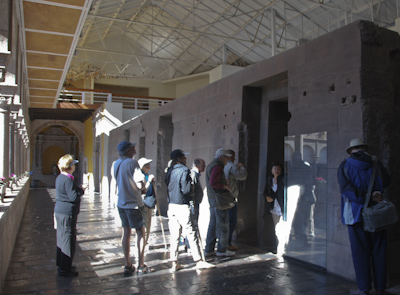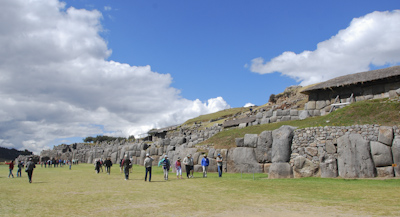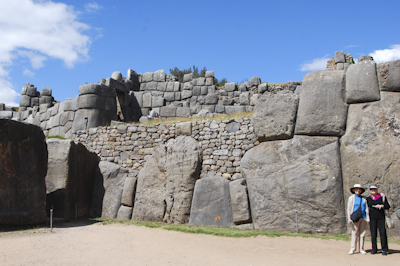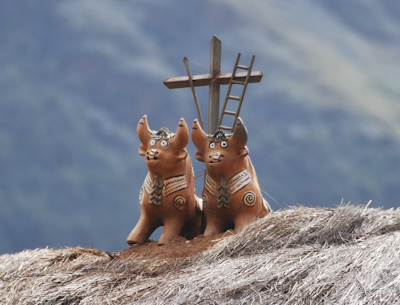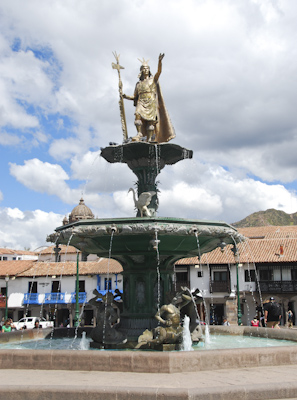Tuesday May 26, 2015 Another bright beautiful cloudless day.
Last night we had just enough time to find our rooms and get ready for dinner at the Monasterio’s elegant dining room. Unfortunately, one of the women in our group became very ill due to altitude sickness. Cusco, located at 11,200 feet above sea level, caused the fierce headaches I experienced during the night. I used the oxygen tank in our room for ten minutes, according to directions, took two Advils, and felt better. We explored the Monasterio grounds briefly and then had a wonderful buffet breakfast outdoors in the garden. Someone commented that the former monastery was still owned by the Vatican, but I find that hard to believe. Nonetheless, it’s a fabulous place to stay and I wish it was at a lower altitude because I would enjoy a return visit.
Marcos, the tour director, warned us about a miners’ strike in southern Peru which might cause us to change our schedule. He promised to keep us posted. Our local guide, Maria, met us at the Monasterio and we went out to see Cusco. Our first stop was Coricancha, the Sun Temple of the Inca. The structure had been used as a shrine for offerings to the sun, as well as a solar observatory, and a storehouse for mummies.
The Incans had covered the south-facing wall with gold to reflect the sun and gold sculptures filled the shrine. After the Spanish conquistadors took over Cusco, they melted down the gold, dismantled most of Coricancha, and built Santa Domingo church and convent on top of the temple. The sacred place of the Incas was hidden until an earthquake in 1955 destroyed most of the newer construction and exposed the solidly built walls.
The site is now a museum and a testament to the ingenuity and skill of the Inca people. The solidly built blocks of stone were precisely carved and placed to create the temple which is expected to last through any future earthquakes.
The city of Cusco had been the capital of the Inca Empire and was known by the Incans as the ‘Navel of the World.’ It is the oldest continuously inhabited city in the Americas and a UNESCO World Heritage Site. Francisco Pizarro and his Spanish conquistadors arrived in Cusco in 1532 driven by their greed for gold. Our next stop was the covered Mercado San Pedro. I love markets! Here were the descendants of the Incas, the Quechua people, shopping for their daily needs.
Afterwards, we continued our tour of Cusco to another UNESCO World Heritage Site. The red tile roofs of houses reached up over the the sides of the mountains surrounding the city as our bus climbed up to the ruins of Saqsaywaman. This is a huge hilltop Incan fortress overlooking Cusco. It is a maze of zig-zagging walls and terraces built from gigantic stones in about 1100 AD. The Incan people’s most ferocious battle against the Spaniards took place here in 1536.
Below is a view of Cusco from an overlook at Saqsaywaman. Today there is a population of 500,000 people living in the city which attracts two million tourists a year. Two flags fly in the plaza: one is the red and white symbol of Peru and the other is the rainbow flag of the descendants of the Inca people: the Quechuas. Maria proudly told us that the people of Cusco are ‘Mixtos’ and the culture and traditions are a combination of Incan and Spanish.
Marcos informed us that a forty-eight hour miner’s strike was planned to begin tomorrow and our south-bound train was canceled. He said he was trying to find transportation for us and we had to leave Cusco today. We would have to take a bus to Puno because all the roads will be closed beginning at midnight. We had time for one more tourist attraction in Cusco, the famous cathedral in the Plaza de Armas.
The baroque Catedral de Santo Domingo was built between 1560 and 1664 from red granite stones taken from the fortress of Saqsaywaman. The cathedral houses several altars and chapels made of beautifully carved wood overlaid with gold and silver. Distinctive “Cusco School” paintings created in the eighteenth century adorn the walls. The most famous of these is a painting of The Last Supper by the Peruvian Quechua artist, Marcos Zapata in 1753. The table is laid with Peruvian food including the Andes delicacy of cuy, cooked guinea pig. (Sorry, no photography in the cathedral!)
There was a lot of activity and so much to see and do in the Plazas de Armas, but we had to return to the Monasterio Hotel to prepare for an early departure to Puno. We were originally scheduled to leave tomorrow on the famous Orient Express Train to Lake Titicaca, but the train company cancelled all trips because of the strike taking place in southern Peru. We learned later there had been riots with bombs and four people had been killed by the military.
We packed quickly and had a light lunch of quinoa soup in the hotel restaurant. Then we boarded a bus and drove out of Cusco about 3:30 for the long ride to Puno. We watched the Peruvian countryside from the window of the coach until darkness and finally stopped for supper about 7:00 PM at a roadside restaurant. The food was cold so I didn’t eat anything except white rice and a few fried potatoes. At 8:10 pm the guide announced that we were passing the highest point of the trip: the town of Raya at 14,200 feet above sea level. We finally arrived at the hotel on the shores of Lake Titicaca close to midnight. It had been a very long uncomfortable drive, but we made it!


